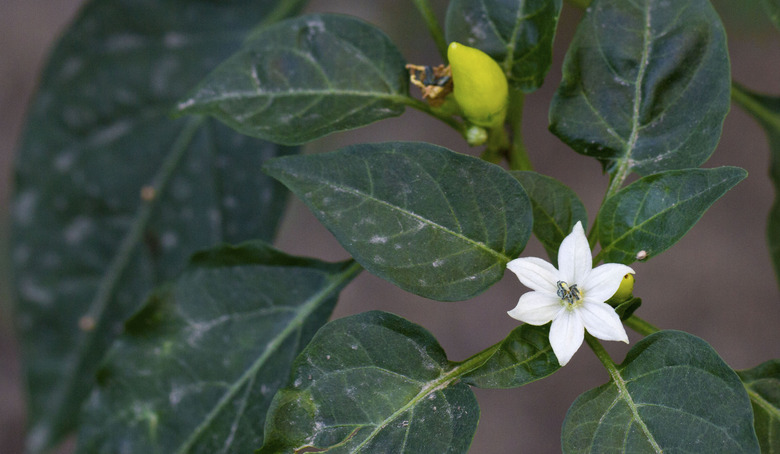How To Grow Trinidad Scorpion Peppers
If you think hot chili peppers are the spice of life, growing "Trinidad Scorpion" (Capsicum chinensis "Trinidad Scorpion") may be just your cup of mouth-scorching tea. Whether in gardens or containers, "Scorpions" yield loads of fiery-red fruit within 14 weeks of planting.
If you think hot chili peppers are the spice of life, growing "Trinidad Scorpion" (Capsicum chinensis "Trinidad Scorpion") may be just your cup of mouth-scorching tea. Whether in gardens or containers, "Scorpions" yield loads of fiery-red fruit within 14 weeks of planting. With a punch to rival its color, the fruit has an average 1.03 million Scoville heat units, among the world's highest. Handle its capsaicin-loaded seeds and membranes with care.
They Like It Hot
Set "Trinidad Scorpions" out when your spring temperatures are consistently above 60 degrees Fahrenheit and your soil has warmed to 65 F. Give them six or more hours of morning and late afternoon sun and well-draining, acidic or neutral soil with a pH between 6.2 and 7.0. To improve your soil's drainage, add a 3- to 5-inch layer of well-aged compost to each planting hole. The compost also feeds the peppers, so fertilizing isn't required.
Watering Garden Plants
While your garden peppers are establishing, water as necessary to keep the soil moist. Once you see new growth, let it soil dry slightly to the touch before soaking the root zones to a depth of 4 feet. To test the moisture level, insert the lower two-thirds of pointed, 6-foot wooden dowel into the ground. If moisture soil clings to the entire 4-foot length when you remove it, you've watered enough.
"Trinidad Scorpion" in Containers
A wine barrel cut in half or traditional pot measuring 16 to 18 inches deep and 2 feet across holds a mature, 2- to 3-foot "Scorpion." If necessary, drill drainage holes in the container's base with a 3/4- to 1-inch drill bit. Before filling it with a mix of three parts commercial potting soil to one part well-aged compost, place the container in its permanent location with six or more hours of daily sun interrupted by afternoon shade.
Container Plant Maintenance
To simultaneously feed and water container peppers, dissolve 2 cups of water-soluble, 10-20-10 fertilizer in 1 gallon of water. Then mix 2 tablespoons of this concentrate in a second gallon of water and pour it around a plant. The University of Florida Extension advises checking potted peppers daily and watering with the diluted growing solution as needed to keep the medium moist. To leach damaging salts from the containers, replace the solution with regular tap water once a week. Do not let the peppers sit in soggy medium.
Pest Control
Sap-stealing aphids and whiteflies attack the peppers' stems and foliage. Green tomato hornworms, wedge-shaped leafhoppers, striped Colorado potato beetles and black flea beetles devour their leaves. Cutworms may chew through young seedlings. Remove by hand and drown hornworms, cutworms and beetles in soapy water. To eliminate aphids, leafhoppers and whiteflies, spray the peppers until they drip with ready-to-use insecticidal soap when the temperature is below 90 degrees F. Wear protective clothing and eyewear and follow the label's directions when handling the soap.
Disease Management
Properly watered peppers resist root and collar rots and fungal or bacterial wilts. If one of yours has wrinkled, mosaic-patterned leaves and stunted growth, tobacco or cucumber mosaic virus is the likely culprit. Remove the pepper for burning or disposal in a sealed bag. Wash your hands thoroughly and disinfect your tools in a solution of one part bleach to nine parts water before working with your healthy plants.
References
- Zipcodezoo.com: Capsicum Chinense "Trinidad Scorpion"
- New Mexico State University News Center: NMSU's Chile Pepper Institute Names the Trinidad Moruga Scorpion Hottest Pepper on Earth
- Mother Earth News: All About Growing Peppers
- The Washington Post: A Cook's Garden: Plant a Mini-Vegetable Garden in a Half-Barrel
- University of Florida IFAS Extension: Vegetable Gardening in Containers
- Harvest to Table: Pepper Growing Problems: Troubleshooting
